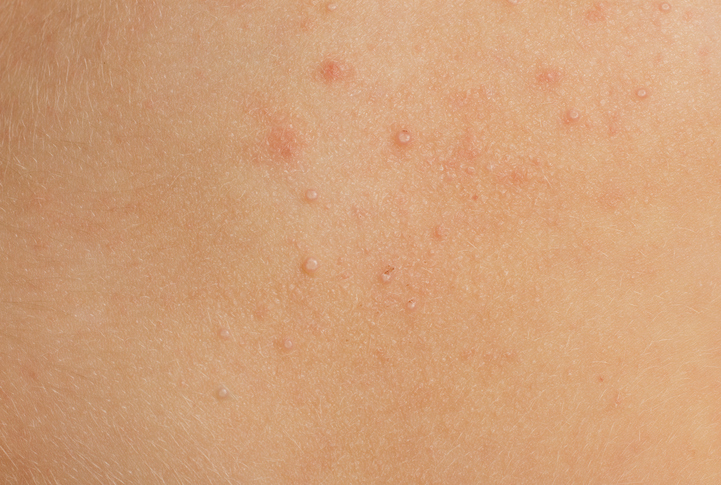
Introduction to Molluscum Contagiosum and what it is
Molluscum contagiosum is an infectious skin condition which is caused by a virus. It is usually seen in children, but can affect adults as well. It presents itself as small, raised bumps or lesions on the skin which are pink or white in color. The bumps may be itchy and can spread from person to person by direct contact with the affected area or by using items such as towels which have been used by someone with the virus. While it is not serious, it can be irritating and uncomfortable for those affected by it.
It is important to take steps to prevent the spread of molluscum contagiosum, especially if you have young children in your home. Good hygiene practices such as frequent handwashing and avoiding sharing personal items like towels are essential. Covering up any bumps with clothing or bandages can also help reduce the risk of spreading the virus to others. Additionally, keeping any infected areas clean and dry can help speed up recovery time. If your child has molluscum contagiosum, you may want to consult a doctor for advice on treatment options.
Causes of Molluscum Contagiosum
Molluscum contagiosum is a skin infection caused by a virus. It is highly contagious and spreads through direct contact with an infected person or object. It can also spread indirectly, such as through contaminated clothing, towels, and other objects. The virus that causes molluscum contagiosum is part of the poxvirus family, which includes smallpox and chickenpox.
Molluscum contagiosum is most common in children between the ages of one and 10 years old, although it can affect people of any age. People with weakened immune systems are more likely to develop molluscum contagiosum, as are those who have recently had a skin injury or have eczema. The virus that causes molluscum contagiosum is highly contagious and can spread quickly from person to person through direct contact with the infected area.
Sharing items such as towels or clothing can also spread the virus. The virus may also spread indirectly, such as through contaminated swimming pools or hot tubs. It is important to take steps to prevent the spread of molluscum contagiosum. Good hygiene practices such as washing hands frequently, avoiding sharing items with others, and keeping cuts and scrapes clean and covered can help reduce the risk of spreading the virus. Visit, Mlb66 ir
Signs and Symptoms of Molluscum Contagiosum
Molluscum contagiosum is an infectious skin condition caused by a virus. It is characterized by small, raised bumps that can appear anywhere on the body, but are most commonly found on the face, neck, chest, abdomen, arms and legs. These bumps can vary in size and usually have a dimple or depression in the center. They may also be itchy or tender to the touch. In some cases, they may form clusters or even spread to other parts of the body. Other common signs and symptoms of molluscum contagiosum include:
- Painless bumps on the skin
- Bumps that are firm and dome-shaped
- Bumps that are white, pink or flesh-colored
- Bumps with a central depression
- Itching or tenderness at the site of infection
- Redness around the affected area
If you suspect you have molluscum contagiosum, it’s important to see your doctor for diagnosis and treatment. Your doctor can confirm a diagnosis by examining your skin and may take a sample of fluid from inside one of the bumps for laboratory testing. Treatment options may include topical medications such as creams or ointments as well as surgical removal.
How to Prevent the Spread of Molluscum Contagiosum
Molluscum contagiosum is a skin condition caused by a virus and can be spread from person to person through direct contact or contaminated objects. The infection is usually harmless but can be bothersome and cause anxiety. Fortunately, there are some simple steps you can take to prevent the spread of molluscum contagiosum.
1. Wash Your Hands Wash your hands often with soap and water for at least 20 seconds, especially after touching any areas of skin affected by molluscum contagiosum. This will help remove any virus particles that might be present on your hands.
2. Avoid Touching Affected Areas Avoid touching any areas of skin affected by molluscum contagiosum, as this can spread the virus to other parts of your body or to someone else. If you must touch the affected area, make sure to wash your hands immediately afterwards.
3. Cover Affected Areas Cover any areas of skin affected by molluscum contagiosum with clothing or a bandage when engaging in activities that involve contact with others such as swimming, playing sports, or going to school or work. Doing so will help ensure that the virus is not spread through direct contact with another person’s skin.
Read, slopes unblocked
4. Don’t Share Personal Items Do not share items such as towels, clothing, razors, makeup brushes, and other personal items with anyone else if you have molluscum contagiosum. These items could potentially carry the virus and spread it to someone else if shared. By following these simple steps, you can help prevent the spread of molluscum contagiosum and keep yourself and others healthy!
Conclusion
Molluscum contagiosum is a highly contagious skin condition, but it can be prevented with proper hygiene and avoidance of direct contact with an infected person. It is important to practice good hand hygiene, avoid sharing items such as towels or clothing, and to cover any lesions with a bandage. Additionally, it is important to visit your doctor if you suspect that you may have contracted molluscum contagiosum in order to receive the proper treatment. With the right precautions and early detection, molluscum contagiosum can be effectively managed.